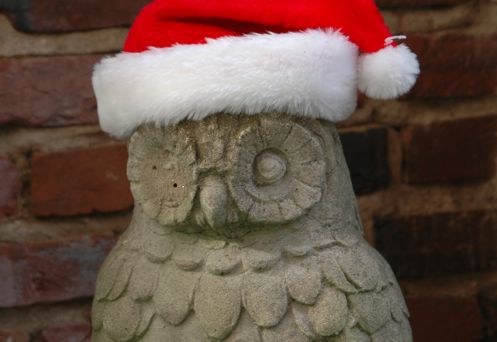You're "kale-ing" me.

A few weeks ago, I ruthlessly yanked the summer annuals from my containers, having come to terms with the fact that they were finished blooming. I don’t like the betrayal of relegating faithful annuals to the compost heap. I fortified myself with flats of pansies (Viola x Wittrockiana), kale, and cabbages (Brassica) beforehand, so the pots would be empty only momentarily, and my guilt would be assuaged by something new to admire.
I went with winter white pansies and cabbages in the back garden, because they are, well, wintery and look beautiful in terracotta pots. I am too stodgy for blues and yellows, which scream “spring” to me, just when I am ready for a bit of winter. Purple kale went in the front pots, which are gray and needed an infusion of warm color.
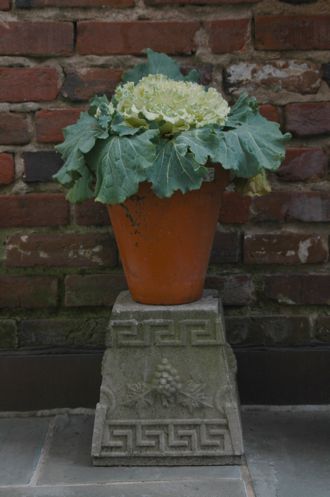
When I was finished yanking and potting, I was pleased with the effect, but, knowing me, I’ll be bored with it all by mid-February. I decided to take a page out of my summer book, and photograph well-planted pots with winter interest so that next year I will have new ideas.
Don’t get me wrong. I love ornamental cabbages and kale for their texture and colors, though I haven’t used them in years. I last planted them in Connecticut but a flock of roving turkeys in search of an early winter Vitamin C fix devoured them overnight, and I was left with the cabbages’ tall, skinny centers, stubby spikes sticking out of my Victorian urns. All I could do was prune them to soil level, their root balls stubbornly frozen into place. I am told that, here, in turkey-free Washington, cabbages and kale look great well into spring.
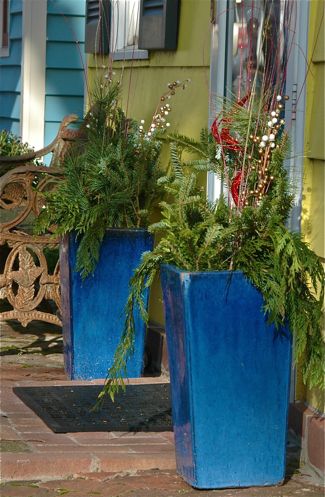
The pansies are cheerful, and “relate”, by design, to the nearby pots with white cabbages. Since the pansies were grown this fall and will be in pots all winter, they’ll have terrific root systems by spring and presumably will bloom prolifically. If I’m tired of all white by the end of winter, I will pop a few colored pansies or primroses among them for a change, being careful not to disturb their more established root systems.
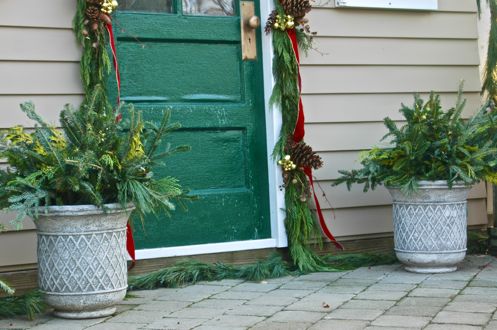
Next winter, however, I might drag my colored ceramic pots out of the attic for a stronger winter statement. The blue ones would be gorgeous in snow, and could be filled with all manner of things, including simple greens and twigs for holiday cheer.
The gray pots in front are antiques, crafted in the early 1900’s and imprinted with the pattern of a buffalo head nickel. They are very stylish planted with purple kale and leftover variegated vinca now, but next year, I might fill them with evergreen cuttings for the holidays, adding gold bells and red ribbons. The evergreens will dry out and fade, and when they do, I can always replace them with pinecones until spring flowers are available.
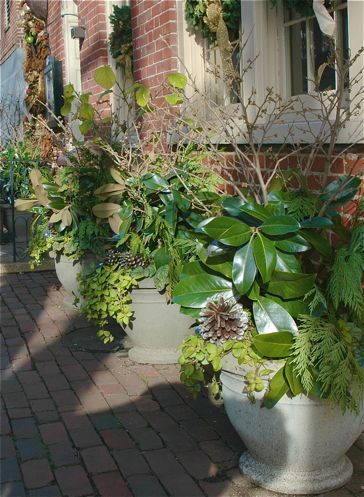
Perennial shrubs can do well in pots, and I was very impressed with a trio I saw in Alexandria. Planted in them
are witch hazels, which will bloom in February or March, and hardy blue plumbago (Ceratostigma plumbaginoides). This dependable little perennial makes a great ground cover and is one of my favorites. It generally loses its leaves in winter, and leafs out late, so you can plant lots of small early spring bulbs through it. Plumbago bears small azure flowers in autumn that persist until frost, depending on how late frost is.
The leaves begin to turn dark red and crimson part way through the blooming period for an eye-catching display. It must have been beautiful in these pots when it was blooming, but because it has finished, the pot designers cleverly filled the void with magnolia and cedar branches, topped off with hefty pinecones. Gorgeous!
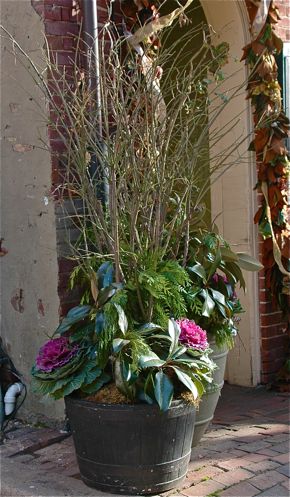
Half whiskey barrels are handsome if you are seeking a less formal look. I came across one filled with magnolia leaves, cedar cuttings, and kale at the base of a burning bush shrub (Euonymous alatus). Burning bush was introduced to the United States in the 1860’s, and has since taken over significant portions of our northeastern woodlands, displacing the native flora and fauna, so it’s considered invasive. My inner-church lady recoils at the thought of planting it anywhere, even in an urban pot. A better choice could be variegated red twigged dogwood (Cornus alba), which has red stems for most of the winter, and cheery green and white leaves all summer long.
There are a number of other great perennials and small shrubs that do well in pots and can be left in place year around. Small leafed shrubs like bog rosemary, dwarf leucothoe, clipped boxwood, pieris, roses, and prostrate junipers can be combined with annuals or, better yet, perennials like grasses, coral bells, and fuzzy, silver leafed lambs ear. If you go this route, you will have year-around interest but you won’t have to do much more than prune, water, dead head spent blossoms, and fertilize during the growing season. If things look a little bare in winter, a few well-placed evergreen or sparkleberry holly twigs, a mulch of Spanish moss, or a ribbon will perk things up until spring.

As a practical matter (I know, who wants to be practical!), it’s important that your pots are either frost tolerant, so they won’t crack when temperatures head south, or that you protect them with insulation (water heater insulation is said to work well) camouflaged with burlap and twine. Plants in pots still need to be watered in fall and winter, and glossy leafed shrubs, like hollies, benefit from anti-desiccant sprays to prevent them from drying out too quickly, especially in windy spaces. It’s best to avoid shrubs and annuals that are just barely hardy, so be sure your selections are hardy to at least a zone or two colder than the one you are in. I know I don’t have to remind anyone to bring in tender plants.
I usually end my pieces with a pithy comment relating properly back to the beginning paragraph, but not so this time. Instead, I’d like to wish you and yours merry holidays, and a happy 2012.
